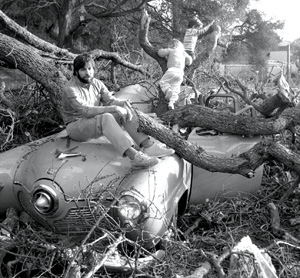

ARCADIA Publishing couldn’t have found a better triple-shot of powerhouse researchers to compile a beautifully twisted hagiography of Sunnyvale than the triumvirate of Ben Koning, Anneke Metz and Michael S. Malone.
These folks dig Sunnyvale probably more than anyone. Malone, an award-winning journo and author of numerous Silicon Valley screeds, wrote the foreword. Koning and Metz compiled the photos, wrote the captions and put together the rest of the book.
Most have seen the Arcadia books, specifically the Images of America series. Historical photo books—maybe 6 inches by 9 inches and around 120 pages or so—they chronicle the stories and histories of specific local niches.
Now we have one on Sunnyvale, and it’s more than overdue. Some Arcadia books come across as ridiculously arcane and hair-splitting, with dubious subcategories and seemingly random inclusions of photos. But Sunnyvale is one of the good ones. The authors present a logical, clear-headed unfolding of the life of this quiet suburb at the center of Silicon Valley. There’s a lot of weird stuff, literally, contained therein.
First things first: Sunnyvale was the first city in California to have a female mayor. Atari started in Sunnyvale. Radio pioneer Arthur Bessey designed some of the world’s first home radio consoles in Sunnyvale. Quite a bunch of real-life missile technology was first designed at Lockheed. In 1972, Nolan Bushnell launched the video game craze when he placed a Pong prototype in Andy Capp’s Tavern (now Rooster T. Feathers). In 1933, the United States government commissioned Sunnyvale Naval Air Station, later renamed Moffett Field. That stuff alone is primo material.
The book begins, as did Sunnyvale, with entrepreneurship and innovation. The town started when Irish immigrant Martin Murphy allowed the San Jose and San Francisco Railroad Company to build a railroad line across his land, linking the farms of San Jose with the docks of San Francisco. Then came wheat and fruit agriculture, with orchards dominating the landscape until midcentury when the defense industry rolled on in. Not too much later, a generation of electronic innovation directly led to what is now Silicon Valley history.
As with the many Arcadia books, the photo selection is what makes or breaks the project. For Sunnyvale, Koning and Metz did all the right legwork in connecting the dots. On page 13, we see a train schedule from 1886, with trains stopping at Murphy’s Station. We then see acres of apricots, homemade tractors, aerial views of canneries, missile production, suburban expansion and Steve Wozniak’s ruined Studebaker after a tree fell on it in 1987. The original Atari 2600 makes an appearance on page 58.
Sunnyvale’s history is soaked in innovation. Mack Wooldridge, founder of Wooldridge Manufacturing Company, first patented a motorized scraper in 1931; the diagram graces page 50. One then turns to page 52 to see A.W. Bessey’s original design for a poultry incubator in 1899.
Inventor Bob Merrick designed the Personal Punch, which cuts notches in business cards for placement in a Rolodex. Millions of the punches have been sold over the years, and the company, which sells many of Merrick’s other gizmos, is still in business today. On page 113, we see an employee inspecting a huge batch of them.
And what would Sunnyvale be without Weird Stuff and the haunted Toys “R” Us? Honestly, I would have thrown the book across the room had it not included those two celebrated landmarks. Originally located on Lawrence Expressway back when Fry’s Electronics was a brand-new enterprise, Weird Stuff now sits way up at the northern end of Sunnyvale. The place is still a vast, venerable temple of discarded computer surplus, a glorious paean to all tech-hobbyist cultures, a mystical vortex that could only have crystallized here in Silicon Valley.
Equally illustrious is the Toys “R” Us, located on original Murphy ranch land. It is said to be haunted by John Johnson, who secretly pined for Martin Murphy’s daughter, Elizabeth Yuba. Strange phenomena still regularly occur, according to some.
All in all, the reader will take home a significant dose of Sunnyvale’s story, told in a logical fashion. It is a rich, kooky history, one to make all valley denizens jump on the expressway and head over there. The book is available at local stores and online.
Arcadia; $21.95
www.arcadiapublishing.com
888.313.2665



